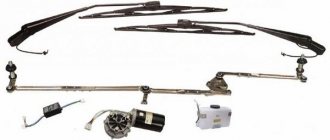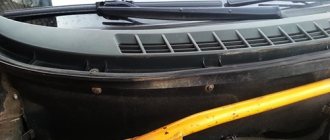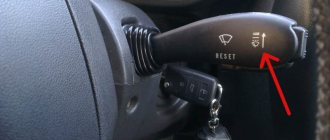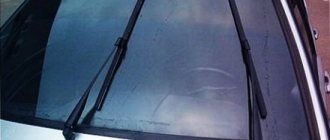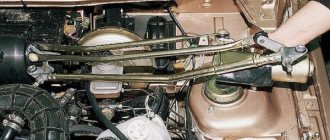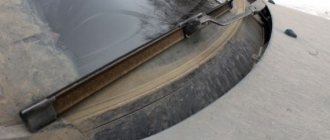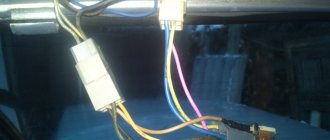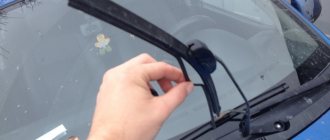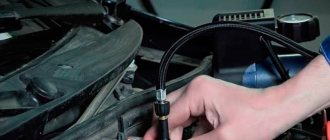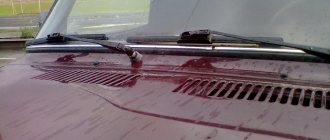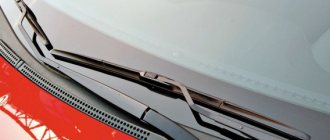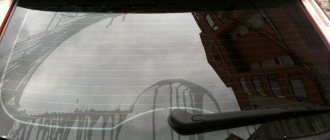Hi all! The problem of windshield wiper failure is familiar to many. One of the reasons may be the pump pumping water to the system. So today they propose to discuss the windshield washer motor.
Externally, the element is quite small, but plays a vital role in the operation of injectors and wipers. In fact, without it, water will not be able to get from the tank onto the windows, and the wipers will simply begin to crawl across the dry windshield, scratching the surface with settled dust or dirt. There's nothing good here.
Device Features
There are new and old motors. The latter can be found on Soviet cars, or on VAZ 2107, 2108, for example.
Most cars, including the VAZ 2109, 2110, 2114, as well as foreign cars Mitsubishi Lancer, Pajero Sport or Ford Focus, already use new types of washer motors (pumps).
The main components of the washer are:
- nozzles;
- pump (motor);
- reservoir with washer fluid.
Nozzles are used to supply water to the windshield of a car. Therefore, they should be positioned so that the outgoing stream of liquid hits the center of the headplate as much as possible. The pump supplies water to the tank. By the way, on some cars, wash water is supplied not only to the windshield, but also to the main headlights in front and behind.
It doesn't matter what kind of car you have. It could be a Priora, a Hyundai Accent, some Mazda or Toyota. All the washer motors work on the same principle. Although the device, characteristics and appearance may vary.
Pumps supply water or washer fluid. If the windshield washer does not work, most likely the reservoir or the nozzles themselves are broken. They can be replaced or repaired yourself.
If the pump breaks, the task is a little more difficult. It is important to immediately identify the problem and fix the breakdown. Driving a car, especially in bad weather, when the windshield wiper does not work, is dangerous.
Causes of malfunctions
Don't rush to blame the engine for everything. It may work, but the windshield wiper does not function for other reasons.
Let's look at the key reasons why our wipers stop doing their job.
- Clogged filter or nozzle. Frequent breakdown. Especially for those who use tap water instead of special washer fluid. To solve the problem, you need to dismantle the devices and flush the system. The work is not difficult, but delicate;
- Supply hoses. They wear out over time, lose their tightness, and burst. Everything is simple here. Remove the old hoses and install new ones. Their price is cheap even on foreign cars;
- Incorrect connection. While carrying out some repair work on the wipers themselves or nearby components, you could disassemble the washer system and reassemble it incorrectly. Check connections and correct errors made during assembly;
- Electric motor and pump shaft. It happens that the connection between them is weak or completely broken. What to do? Right. The element needs to be better secured;
- Motor failure. It doesn’t happen that often, but you shouldn’t rule out this option. Before changing a part, try to clean the motor and its brushes, and get rid of all traces of corrosion. Sometimes it helps. If the repair does not produce results, replacement will help.
Here are the main causes of windshield wiper failure. It is not the most complex mechanism in a car, so you can repair it yourself.
Block under the hood
It is located next to the washer fluid reservoir, under the protective cover.
Description
Option 1
| F1 | 10A Emission control system |
| F2 | 15A Emission control system |
| F3 | 15A Emission control system |
| F4 | 10A Emission control system |
| F5 | 30A Diesel combustion products filter evaporator, Glow plug control system |
| F6 | 3A Anti-lock braking system. Maintaining sustainability. Ignition |
| F7 | 7.5A Powertrain control module |
| F8 | 20A Cooling Fan |
| F9 | 30A Left windshield wiper |
| F10 | 30A Right windshield wiper |
| F11 | 10A Air conditioning compressor clutch |
| F12 | 20A Glow plug for the evaporator of the diesel combustion product filter |
| F13 | Reserve |
| F14 | 30A Emission control system - ignition |
| F15 | Not used |
| F16 | Not used |
| F17 | Not used |
| F18 | 40A Anti-lock brakes, stability control pump |
| F19 | 30A Starter Solenoid |
| F20 | 60A Glow plugs |
| F21 | 60A Ignition relay 3 |
| F22 | Reserve |
| F22 | Reserve |
| F23 | Reserve |
| F24 | 7.5A High Pressure Fuel Pump |
| F25 | Reserve |
| F26 | Reserve |
| F27 | Reserve |
| F28 | Reserve |
| F29 | Reserve |
| F30 | 40A Cooling fan 1 |
| F31 | 40A Fan 2 cooling systems |
| F32 | 60A Electric motors (two) windshield wipers |
| F33 | 20A Start-stop auxiliary water pump |
| F34 | Reserve |
| F35 | 15A Power supply for powertrain control system |
| F36 | 15A NOXI 2 sensor |
| F37 | 7.5A Volume control valve |
| F38 | 7.5A Mass air flow sensor |
| F39 | 15A Diesel Pump Fuel Evaporator |
| Relay | |
| R1 | Ignition |
| R2 | Starter |
| R3 | Rear window wiper |
| R4 | Not used |
| R5 | cooling Fan |
| R6 | Windshield wiper - on and off |
| R7 | Windshield wiper - low and high speed |
| R8 | Not used |
| R9 | Not used |
| R10 | Air conditioning compressor clutch |
| R11 | Evaporator system fuel glow plug |
| R12 | High pressure fuel pump |
| R13 | All Wheel Drive Pump |
| R14 | Econetic system |
| R15 | Cooling fans: high speed and low speed |
| R16 | Emission control system |
| R17 | Powertrain Control Module |
| R18 | Cooling fan - high speed |
Option 2
| F1 | 5A Switching off the radio sound |
| F2 | Reserve |
| F3 | Reserve |
| F4 | Reserve |
| F5 | Reserve |
| F6 | 15A Nitrogen oxide sensor |
| F7 | 15A Particulate Sensor |
| F8 | 20A High Speed Cooling Fan |
| F9 | Reserve |
| F10 | Reserve |
| F11 | Reserve |
| F12 | Reserve |
| F13 | Reserve |
| F14 | Reserve |
| F15 | Reserve |
| F16 | Reserve |
| F17 | Reserve |
| F18 | 40A Cooling Fan 2 |
| F19 | 40/60A cooling fan |
| F20 | 40A Emission control system |
| F21 | 40A Glow plug 2 |
| F22 | 40A Glow plug 1 |
| F23 | 10A Air conditioning compressor clutch |
| F24 | Reserve |
| F25 | 15A Right headlights with high intensity discharge lamps |
| F26 | 15A Left headlights with high intensity discharge lamps |
| F27 | Reserve |
| F28 | 5A Heating element for positive crankcase ventilation valve |
| F29 | 7.5/15A Coolant pump |
| F30 | 40/60A Powertrain Control Module Relay |
| F31 | 20A Run-start relay 2 |
| F32 | 20A Fuel fired auxiliary heater |
| F33 | Reserve |
| F34 | Reserve |
| F35 | 20A Powertrain Control Module |
| F36 | 20A Power wire 5 car |
| F37 | 15A Tank with reagent. Exhaust gas recirculation valve |
| F38 | 10A High speed cooling fan. Air conditioning compressor clutch. Low speed cooling fan. High and low speed cooling fan relay. Relay coils R1, R5, R10, and R15 of the engine electrical junction box |
| F39 | Glow plug control system |
| Relay | |
| R1 | High speed cooling fan |
| R2 | Not used |
| R3 | Rear window wiper |
| R4 | Air suspension module |
| R5 | Cooling Fan |
| R6 | Not used |
| R7 | Left headlights with high intensity discharge lamps |
| R8 | Right headlights with high intensity discharge lamps |
| R9 | Starter |
| R10 | Air conditioning compressor clutch |
| R11 | Not used |
| R12 | Not used |
| R13 | Emission control system catalyst |
| R14 | Not used |
| R15 | Low speed cooling fan |
| R16 | Not used |
| R17 | Not used |
| R18 | Powertrain Control Module |
Replacement
If the old motor has failed, there is no point in trying to repair it somehow. To buy a new part, you will have to spend very little money. And the replacement procedure on most cars is extremely simple.
I will describe the main stages of work associated with replacing this element of the windshield cleaning system of any car.
- Turning off the vehicle's power. A safety measure without which further work makes no sense. Be sure to remove the negative terminal from the car. It's simple but important. Otherwise, you not only risk burning the wiring, but also getting an unpleasant electric shock yourself.
- Search for a motor. It all starts with identifying where your windshield wiper motor is located. It depends on your car. On some cars, just lift the hood and you will immediately see the washer reservoir. The motor itself is located on the reservoir (partially inside) of the windshield wiper, into which the liquid is poured. Do you see the tank? If yes, then you are in luck. If not, then you will have to look for it by removing elements of the engine compartment. On some car models, the tank is hidden so that the fender protection has to be removed.
- Disconnect the connectors with wires from the motor. Then remove the tank itself.
- The hose and fitting are separated from each other. Don't forget to drain the liquid. Filling a new one will not be difficult. Yes, and for prevention it won’t hurt to do it.
- Using a screwdriver, push the intake seal out of the bushing. This will allow you to completely remove the windshield washer motor.
- Don't forget to install a new bushing when reassembling. This often leads to the washer pump itself breaking down. So the old bushing goes to the landfill.
- Reassemble the assembly in reverse order. Here many craftsmen relax, because they consider the work done. In fact, reassembly causes more problems than disassembly. Advice from someone who made similar mistakes. That is, from me. Do not try to remember the location of parts unless you are confident in your memory capabilities. We got distracted by something, forgot, got confused. This happens to everyone, and there is nothing wrong with it. To ensure proper reassembly sequence, you can record, mark, or label the parts in the order in which they are removed. This will make it easier to put everything back together the way it was before.
How does a windshield wiper work in cyclic mode?
The windshield wiper is functional when the wiper blades make one movement within 10 seconds, which of course makes driving a car much easier during drizzling and heavy rain. This mode is available for any car; to do this, it is enough to use the PC514 relay from a VAZ car.
Windshield wiper relay wiring diagram. How does the windshield wiper relay work?
1 – relay RS 514; 2 – two-pole toggle switch; 3 – wire; 4 – windshield wiper; 5 – windshield wiper limit switch; terminal designations; Zh – yellow; B – white; K – red; C – blue.
Relay 1 has 4 pins. The plus of the on-board network is transmitted to the yellow wire, the two-pole toggle switch is connected to the red and blue wires. In order to ensure that the wiper blades stop, the non-grounded contact must be connected to wire 3.
In this case , the wiper will operate in cyclic mode when the toggle switch is moved down. Although you can buy a special windshield wiper cycle regulator, with which you can select the cycle of operation from 2 to 15 seconds.
The main causes of windshield washer problems
It is necessary to distinguish between the washer system and the wipers. If the windshield wiper blades are operating, driving is possible in wet weather, but dirt will be carried across the glass and can create scratches on the surface. When it rains, only wipers are needed for a normal trip. But if the weather is not too wet, and dirt is still rising from the road, you need a high-quality washer that performs all its functions.
In domestic cars, the system often breaks down in the area of the washer reservoir or the motor that pumps liquid to the nozzles. The outlet tube is attached to the motor using a plastic transition, which tends to break. If this unit breaks down, you will have to replace the entire motor; there is no point in gluing and restoring the old unit. Common problems associated with the washer system on any car are as follows:
- rupture of the hoses through which the liquid flows to the sprayers for cleaning the windshield;
- pinching of hoses and lack of normal fluid supply for the functioning of the system;
- a crack in the washer reservoir, due to which all the liquid disappears within seconds after filling;
- poor quality or loose attachment of the hose to the tank, motor or injectors;
- clogged nozzles, which are used to spray liquid directly onto the windshield;
- failure of the motor and cessation of the flow of liquid under pressure for its normal spraying.
Problems with incorrectly attached hoses or slightly clogged nozzles can be resolved on site. To do this, you just need to tighten the clamps so that the liquid does not leak out on its own. In the case of sprayers, you need to remove them and blow them out. These types of problems are the most common, but other problems are almost impossible to fix on your own. However, you should be able to determine the type of fault that has occurred.
At a service station that is not very responsible, you may be given a terrible bill with a large list of work that does not correspond to reality. But in reality, the hose from the washer reservoir was simply replaced, which costs a penny. Therefore, it is important to understand the cause of the problem, especially since this system is quite simple. All elements of the washer system can be observed under the hood and determined which particular unit has failed. Things are more complicated with wipers.
Additional Information
How to change the cigarette lighter fuse
Here is an example of how to correctly change the cigarette lighter fuse on a BMW X3 E53.
Russian translation of errors from the dashboard
RELEASE PARKINGBRAKE-Release the parking brake CHECK BRAKE FLUID-Check the brake fluid level STOP! ENGINE OILPRESS-Stop! Low engine oil pressure COOLANT TEMPERATURE-Coolant temperature* BOOTLID OPEN-Trunk open DOOR OPEN-Door open CHECK BRAKE LIGHTS-Check brake lights CHECK LOWBEAM LIGHTS-Check low beams CHECK TAIL LIGHTS-Check tail lights CHECK PARK LIGHTS-Check side light CHECK FRONT FOGLAMP-Check front light. fog lights CHEK REAR FOGLAMP CHECK NUMPLATE LIGHT CHECK TRAILER LIGHTS CHECK HIGHBEAM LIGHT CHECK REVERSE LIGHTS CHECK REVERSE LIGHTS TRANS. FAILSAFE PROG-Automatic transmission emergency program CHECK BRAKE LININGS-Check the brake pads WASHER FLUID LOW-Add water to the washer reservoir CHECK ENGINE OIL LEV-Check the engine oil level IGNITION KEY BATTERY-Replace the ignition key battery CHECK COOLANT LEVEL-Check the coolant level LIGHTS ON ?-Is the light on? CHECK STEERING FLUID LEV - Check the hydraulic steering oil
Troubleshooting your washer system yourself
Almost all drivers want to be able to fix any simple problems themselves, because this can save a fairly large amount of money. For this reason, most car owners today are actively studying vehicle repair and maintenance manuals. We indicated above that poorly attached hoses and clogged nozzles can be corrected on the spot with a simple set of tools.
If the injectors are clogged sufficiently, you will have to resort to the help of specialists. To clear such a blockage, it is necessary to use strong pressure of water or air. Often on budget cars it turns out to be cheaper to purchase new injectors and install them on the car. Other problems are quite difficult to resolve, but almost all processes can be performed independently:
- if the washer pump mounts break or there is a problem with the motor itself, you need to buy a new device and replace it by installing it in place of the old one;
- if the washer reservoir is cracked, it is also not worth repairing, because the chemicals will still corrode the glue and find the resulting gap;
- if the hoses break, it is worth purchasing new hoses and installing them with high-quality clamps in their place of work;
- if all parts of the system are visually in good condition, the possible culprit of the breakdown is the washer switch relay, which can also be easily replaced;
- The system activation button itself, located in the steering column, also often fails and can be easily replaced.
Let's sum it up
Repairing a car yourself is quite difficult, so most motorists try to find a good inexpensive service to carry out repair work. But you need to know the structure and functioning of the simplest systems yourself, because it is not always possible to turn to specialists when problems arise. Often breakdowns catch us on the road, and also do not give us too much time to resolve problems.
For this reason, it is better to use your own knowledge and be able to fix the problem, even if it is not time to continue operating the machine. With such capabilities, you can easily obtain the desired operating conditions for your car, and also ensure the normal functioning of important systems. Have you ever had serious washer problems in the middle of the road?
The importance of a windshield washer cannot be underestimated. It is able to provide comfortable movement on the road in bad weather. There are cases where people got into accidents due to a malfunction of this element. Let's take a look at why your windshield washer doesn't work and how to fix it. First you need to figure out how everything works and what could cause the problem.
We treat and improve
Surely all owners know that even a fully functional system produces little pressure. The reason for this is the low power of the standard motor. If the windshield washer does not work on a VAZ 2109, you can eliminate the cause and at the same time tune the system by installing a pump from:
To be completely sure, you can install:
- fan injectors (for example, from Volvo S80);
- a check valve that prevents fluid from draining from the rear injector line;
- filter to prevent clogging of nozzles.
Operating principle of the device
So, an electric pump is currently being installed; previously it was a mechanical one. We also have a tank in which the glass spray liquid is stored. Naturally, there are two tubes through which it flows to two sprayers. The volume of the tank can be 2.5-5 liters, which is quite enough for a long period of operation, due to the efficiency of the injectors. The electric pump located in the reservoir is activated by the steering column switch. This way, cleaning liquid is supplied to the windshield and the wipers turn on for a while.
Ordinary water is used as a working fluid - this applies to the summer period, but in winter, when it is cold, a special “anti-freeze” is added there. Two types of nozzles are used: jet and fan. It’s difficult to say which is better; both of them give excellent results. That’s probably all that concerns the device and operating principle of the washer.
The most common problems
Let's start with the simplest ones and end with faults that require serious repairs to the electric pump and other elements. During the cold season, the liquid in the tank often simply freezes. This is not fatal, but you need to be careful, because expansion may cause the plastic to burst. We need to melt the liquid inside. To do this, you can use a household hair dryer or something like that.
It is unacceptable to use chlorinated water. This is due to the fact that this leads to rapid clogging of the hoses, and as a result, the nozzles also become clogged. At the most inopportune moment you will have to clean. In fact, the most common faults occur in electrical circuits. Sometimes it is a mechanical problem. Please also note that quite often the hoses jump off, so the liquid simply does not reach the nozzles and is lost along the way. The same applies to banal cracks that appear due to aging or bending.
What to do if the washer motor does not work
It is worth noting that this problem does not happen very often. In most cases, you have to completely remove the device and try to repair it. If you press the washer lever and the electric pump does not hum, then this is a clear sign that it has failed. You can also check the incoming voltage. If the required 12 V is available, but there is no work, then replacement or repair is needed. As for trying to restore the device, in most cases this does not make sense, since it is cheaper and easier to buy a new product.
But don’t rush, because if you notice a problem during the cold season, the reason for the lack of buzzing may simply be freezing. Therefore, you need to try to warm it up, this may help. If this is the reason, then the motor will start working on its own after it thaws, otherwise you will have to change it, and now we will see how this should be done.
Replacing the electric washer pump
Essentially, there is nothing complicated here. We will hardly need any tools. First of all, you need to purchase a new washer that will fit your car. The next step is draining the liquid from the tank. Next, disconnect the battery ground and disconnect the electric pump contact. The next thing to do is to unscrew a few bolts that secure the now empty washer reservoir. In principle, if you can get the electric pump and disconnect the hoses, then you don’t have to do this, but, as practice shows, it is much more convenient to carry out work with the tank dismantled.
Next comes the assembly process. By and large, it is similar to disassembly. You even need to maintain the position of the hoses, because if you mix them up, you will have to do additional work. Once you have everything assembled, screw the tank back to the bracket. That’s essentially all, now you can test for performance.
We disassemble the turn switch for a VAZ 2107
And although many manufacturers of turn switches claim that this is a completely non-separable design, it can still be disassembled with some effort. Disassembly of devices is necessary when repairing it. It takes place in several stages:
- Using a 3 mm drill, drill out the 2 upper rivets and remove the upper part that is attached to the tube;
- After removing this part we see 2 more rivets that hold the ring;
- Carefully remove the ring from the grooves, then you need to remove additional rings and levers.
Windshield washer does not work: causes and solutions
As noted above, there are many problems, which we will talk about now. If your windshield washer does not work, then it is quite possible that the problem is clogged nozzles. But you can’t just clean them. To do this, you need to take distilled water and mix it with vinegar in a 1:1 ratio. You need to turn the washer on and off several times and expel all the salts that have collected in the nozzles. It is advisable to leave this solution for some time (1-2 hours), then remove it and rinse the system with simple distillate.
It should also be said that the reason may be in the fuse. It may burn out or not work due to oxides. This is what you should check first. Also, periodically inspect the integrity of the tank, because during the next maintenance service it may be damaged and not told to you about it. Since it is plastic, this is quite easy to do. Even if the hole is small, the working fluid will leave the system fairly quickly.
Prevention measures
In order to avoid sudden problems with the operation of the windshield washer system, you must:
- promptly refill the washer reservoir with antifreeze liquid and remove water from the system;
- check the quality of the antifreeze in the freezer; it is better to buy liquid at a gas station;
- remove the chip from the pump and inject silicone grease into the contact area, it pushes water out of the contact area, preventing corrosion;
- if the tubes crack, replace them with serviceable ones, you can take silicone tubes from an IV (sold at any pharmacy);
- When operating a vehicle at temperatures below minus 25 degrees Celsius, it is recommended to install heated injectors.
Electrical problems
We must not forget that there are terminals on the motor, and they oxidize, bend, etc. Therefore, they need to be inspected and cleaned periodically. There is nothing complicated here. We disconnect the contacts, take sandpaper, a metal brush or something like that and clean it. Then we install the terminal and check it.
Another common electrical failure is the failure of the washer relay switch. In this case, we will need to replace it. Obviously, the glass washer does not work even when there are problems with the fuse box, but this has already been mentioned above. You need to understand that if mechanical damage can be detected during a visual inspection, then with electrical faults the situation is a little different, and therefore the repair will take a little longer.
Some useful tips
If your injectors are faulty, they need to be replaced. Typically, you can choose which ones you want to install. Fan-type nozzles have advantages. They are good because they completely wet the entire area of the windshield, therefore, the wipers will work with a bang.
If your rear window washer does not work, then most likely the reason is a fluid leak or a clogged hose. You can try to fix the problem using compressed air. To do this, disconnect the hose from the injector side, disconnect it from the electric motor and blow it out. Of course, if there is a leak, this will not help. Here you need to completely change the hose. As you can see, there are many reasons why the washer does not work, but due to the fact that the device itself is not very complicated, all of them can be found quite quickly.
Mechanical breakdowns
The most common reasons why the VAZ 2114 windshield washer does not work are mechanical damage.
The most common of them are:
- the washer fluid has run out in the tank;
- the pipeline leading to the windshield wiper is clogged;
- the windshield wiper nozzles are clogged;
- the water used as washer fluid froze;
- the hose fell off the pump;
- the hose going to the windshield wiper is pinched;
- The supply hose has ruptured.
Problems related to washer fluid can be solved almost instantly - if it runs out, it should be topped up; if it is frozen, take the expansion tank to a warm room, warm it up, then drain the water or liquid that is inappropriate for the season and fill it with non-freezing one.
